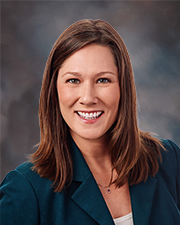The March 2024 WBA Compliance Journal is now available. In this edition, readers will find an article regarding DOR issuing an emergency rule to interpret state commercial loan income exemption. The “regulatory spotlight” section sets forth summaries of recently published agency rules and notices, and the “compliance notes” section provides other important compliance-related updates for bankers.
Posts
 By Scott Birrenkott
By Scott Birrenkott
As of January 1 of this year, many companies must report beneficial ownership information (BOI) to the Financial Crimes Enforcement Network (FinCEN) (referred to as the BOI reporting rule) as part of implementation of the Corporate Transparency Act (CTA). Reporting companies include most corporations, limited liability companies, or others created by the filing of documents with Wisconsin. This information must be reported directly to FinCEN through its online reporting portal. The Wisconsin Bankers Association is often asked: what does this mean for banks? For example, are banks required to ensure their customers report accurate information? In some respects, the answer is this rule doesn’t mean anything for banks. There’s a little more to the conversation than that, though.
When talking about the new BOI reporting rule, it’s important to make a distinction from FinCEN’s other reporting rule: the Customer Due Diligence (CDD) rule. The CDD rule became effective in 2018 and requires banks to identify and verify the identity of beneficial owners of legal entity customers. In short, it requires banks to collect a certification of beneficial ownership for certain companies. The CDD rule and BOI reporting rule are separate. The CDD rule has not changed since 2018, and the BOI reporting rule places no additional obligations upon banks. Meaning banks are not required to ensure their customers report under the BOI rule or verify the accuracy of that information. However, banks must continue to meet the requirements of the CDD rule.
Thus, if customers have questions regarding their BOI reporting requirements, they should be directed to FinCEN for further information. FinCEN maintains a variety of helpful resources on its website to help companies understand who must report, what they must report, when, and how. Additionally, WBA has created resources for banks to further understand the differences between the rules, as well as customer facing resources to better help banks work with companies who might have questions for them. These resources can be found on the WBA website.
Lastly, there is a third rule worth discussing as part of this conversation. As mentioned at the beginning of this article, the BOI reporting rule is part of FinCEN’s efforts to implement requirements mandated by the CTA. As part of this implementation, FinCEN issued a third rule in 2022, in addition to those discussed above, often referred to as the Access Rule. The Access Rule prescribes the circumstances under which BOI reported to FinCEN may be disclosed to authorized BOI recipients, and how it must be protected. The Access Rule does not create a new regulatory requirement for banks to access BOI from the system or a supervisory expectation that they do so. The prudential federal regulatory agencies issued joint guidance in December of 2023 stating this fact.
By Aubree S. Rehmke
I have spent my entire career working for financial institutions. After graduating from college, I started as a teller and quickly transitioned my way through several positions spending the majority of my profession as a compliance officer and BSA officer for a small community bank. Today, I work as a consultant with Vantage Point Solutions performing audit and consulting services for small to mid-sized financial institutions.
Over the years I have met many novice compliance professionals, and one commonly shared frustration I hear is that they aren’t sure where to start. In the span of almost twenty years, I have learned many lessons (and have made many mistakes). I want to pass that knowledge on to those who may be lacking the mentorship that is essential to navigating this role. So, if you are reading this and you are new to compliance management, here are my two cents on the things you can do to make this job a little easier for you.
Get Organized
Compliance officers are expected to know and manage a considerable amount of information; from policies and procedures to consumer regulations to monitoring and training. Therefore, it is extremely important to build a compliance management program, or what we in the profession sometimes call our “house of compliance.”
Some institutions have the luxury of purchasing software to help manage the compliance function. However, if you are like me and do not have that convenience, then you may need to build your “house” from scratch. It works best for the compliance department to maintain a folder on the institution’s network or intranet where all the electronic compliance-related items are stored. For ease of use, this “house” can be organized in such a way as to include a separate folder for each of the pertinent compliance areas, for example:
- Board & Management Oversight – used to house all of your board reports, requests for approval, compliance committee meeting minutes, etc.
- Policies – used to store all the institution’s approved written policies as well as the annual policy reviews and amendments.
- Procedures – used to store all of the institution’s written procedures; consider breaking this down by department, and then possibly by task or function.
- Risk Assessments – used to house all of the compliance-related risk assessments; organized by annual review year or by type of assessment.
- Monitoring & Auditing – used to store ongoing monitoring functions performed by the compliance and/or BSA role in addition to third-party compliance audits, self-reported violations, corrective action, remediation tracking, etc.
- Training – used to store compliance training organized by year or topic in areas such as online course assignments, handbooks, materials, employee acknowledgments, board training, etc.,
- Consumer Complaints– used for all consumer complaints, incidents, investigations, logs, responses, and management reports.
- Change Management – used to store the tracking of new or changing regulations, products and services, and new business processes or strategies.
- Regulatory Exams – used to store regulatory exam information, request lists, collected exam documents, exam reports, and corrective action/remediation.
- Compliance Library – used to store all of your tools, news articles, agency notices, FAQs, checklists, worksheets, flowcharts, training materials, and any other resources you have collected over time to aid in the compliance officer role; organized by topic or regulation.
Now, obviously, this is just one way to do it. In my experience, this folder system ran like a well-oiled machine after the initial setup. After you create some kind of organization for your electronic house of compliance, you will be more efficient and find it easier to locate important documents and other resources. If you have inherited the previous compliance officer’s folder system, consider taking the time to reorganize it into a structure that will work best for you and your organization.
Create a Project Tracker
With so many different projects occurring at different points throughout the year and at different frequencies, consider maintaining some kind of project tracker. Again, if you are not using software to assist in managing this function, I highly recommend an Excel spreadsheet and/or setting calendar reminders or tasks. The tracker or calendar can be comprised of all the different compliance projects, tasks, and responsibilities you need to complete throughout the year, whether routine or one-time, and can include important data such as:
- the name of the project
- the name of the individual(s) assigned to champion the project
- the frequency of the project
- the next due date
- a brief description of the project
- where the information is to be reported once completed
Once projects are completed, they can be marked accordingly or simply adjust the due date to the next frequency for repeat tasks.
Know Where Your Resources Are
My philosophy on the role of compliance officer is not necessarily memorizing all the rules and regulations, but rather knowing exactly where your resources are. When I started in compliance, nobody taught me how to find banking regulations — I wasted a lot of time thumbing through old training manuals or googling regulatory citations. Compliance professionals should know how to research rules, regulations, and statutes directly from the primary source materials, and also be alerted when something new is coming down the pipeline.
One of the main resources for researching regulations is found on the Code of Federal Regulations website, or the eCFR system, particularly Title 12 and Title 31 where many of the banking regulations are located. Banking regulations can also be found on the federal agencies’ websites depending on which agency has authority over the regulation.
- FDIC – Rules & Regulations
- Federal Reserve – Regulations
- OCC – Laws & Regulations
- CFPB – Interactive Regulations
- NCUA – Rules & Regulations
- FTC – Statutes and Regulations
- FinCEN – Legal Authorities
The federal agencies publish their exam manuals which can often be helpful when looking up regulatory information or building an internal audit program.
- FDIC – Consumer Compliance Examination Manual
- Federal Reserve – Supervision Manuals
- OCC – Controller’s Handbook
- CFPB – Supervision & Exam Manual
- NCUA – Manuals & Guides
- FinCEN – BSA/AML Examination Manual
The agencies also publish communications that are helpful when new information is announced, many of which you can subscribe to receive via email.
- FDIC – Financial Institution Letters
- Federal Reserve – Supervision & Regulation Letters and Consumer Affair Letters
- OCC – Bulletins
- CFPB – Supervisory Guidance
- NCUA – Letters to Credit Unions
- FTC – Consumer Alerts
- FFIEC – Press Releases & Announcements
- FinCEN – Advisories
It is in your best interest to subscribe to several banking e-newsletters and compliance publications directly from bankers’ associations and other secondary resources. I highly recommend signing up for as many email communications as possible so you don’t inadvertently miss important information that may affect your institution.
Create Alliances with your Colleagues
When I was a compliance officer, one of the most routine methods for regular and consistent contact with colleagues came from the compliance committee. During my time at the bank, our committee was comprised of leadership from several departments, including the bank president. This was perhaps the most substantial opportunity for me to meet with management and discuss consumer compliance topics in lending, deposit, operations, as well as BSA. Each department leader was responsible for agenda items within their area of expertise, which can be an excellent way to create accountability and a culture of compliance within the institution. With this in mind, it is important to note that compliance can be a shared responsibility; the burden does not necessarily need to fall on one person alone. After building a strong rapport with the committee members, you will find it easier to collaborate on projects in between meetings as well.
In addition to creating alliances through the compliance committee, compliance officers also need to be transparent and responsive to all employees within the institution. Remember, you are likely their primary source of regulatory guidance and information. When they have questions, you are responsible for researching the answer which makes being approachable and collaborative essential qualities.
Build a Network of Compliance Friends
Unlike other areas within the banking industry, compliance is not competitive. In my experience, compliance professionals are eager to share tools and resources with each other. If another compliance professional has already developed a risk assessment, or a checklist, or knows of a process that works well and is willing to share — take advantage. Why reinvent the wheel? And, the relationship should work both ways so don’t forget to share your ideas too; obviously, do not share proprietary or confidential information.
How do you meet these “friends”, you ask? Well, one way is to attend compliance conferences and schools. It can be difficult to build a network of compliance friends if you only ever attend virtual events, therefore, meeting with other compliance professionals in person is crucial. Get out there and meet people. Typically, these events will host networking lunches and socializing opportunities to help introduce novice compliance officers to more seasoned ones. If you get the chance to attend any in-person events, I highly recommend you join the networking events and exchange business cards.
Another way you can meet fellow compliance professionals is through local or online peer groups. You can also develop connections with your external auditor, outside consultants, and state bankers’ association. Each of these relationships can provide meaningful and long-lasting resources throughout your career.
Don’t Forget Your Lead Examiner
The last piece of advice I will leave you with is this: don’t forget to build a relationship with your lead examiner. Financial institutions are assigned a lead examiner by their federal regulator, and it is important to have a good rapport with this person. Whenever I felt challenged by a complicated regulatory issue or wanted an expert’s opinion on a matter beyond my scope of expertise, I reached out to my examiner. In my experience, the examiner was more than willing to accommodate my inquiries and provided me with quality feedback. I also made an effort to attend events hosted by the regulatory agency which provided another opportunity to meet with examiners in between exam cycles.
Regulatory compliance has been a challenging and rewarding career path for me. Even now as a consultant, I continue to learn something new all the time. I have a passion for working in bank compliance and enjoy partnering with community bankers to help build successful compliance programs. I hope you find your career equally fulfilling.
Rehmke is a risk and regulatory compliance consultant for Vantage Point Solutions, a WBA Associate Member.
About the Author
 Aubree S. Rehmke is a Risk and Regulatory Compliance Consultant for Vantage Point Solutions based in South Dakota. Aubree has almost 20 years of experience in the financial services industry, and she has a passion for mentoring employees new to their roles in compliance and BSA. For most of her career, she served as the compliance officer and human resources manager for a small community bank in eastern Iowa. Aubree is a Certified Regulatory Compliance Manager and brings a broad range of regulatory and consumer compliance knowledge to the Vantage Point financial services team. She holds a B.A. from The University of Iowa and a diploma from the Graduate School of Banking at the University of Wisconsin-Madison where she also earned a certificate in executive leadership. Aubree resides in Dubuque, Iowa.
Aubree S. Rehmke is a Risk and Regulatory Compliance Consultant for Vantage Point Solutions based in South Dakota. Aubree has almost 20 years of experience in the financial services industry, and she has a passion for mentoring employees new to their roles in compliance and BSA. For most of her career, she served as the compliance officer and human resources manager for a small community bank in eastern Iowa. Aubree is a Certified Regulatory Compliance Manager and brings a broad range of regulatory and consumer compliance knowledge to the Vantage Point financial services team. She holds a B.A. from The University of Iowa and a diploma from the Graduate School of Banking at the University of Wisconsin-Madison where she also earned a certificate in executive leadership. Aubree resides in Dubuque, Iowa.
Vantage Point Solutions offers Virtual Compliance Officer and Virtual BSA Officer services including mentoring programs. If you are interested in these services, contact Aubree at Aubree.Rehmke@vantagepnt.com.
The February 2024 WBA Compliance Journal is now available. In this edition, readers will find an article regarding agency examination principles related to valuation discrimination and bias in residential lending, an overview of FRB’s top compliance examination violations from 2022 exam data, and a new resource for helping to identify number of total units for HMDA LAR purposes. The “regulatory spotlight” section sets forth summaries of recently published agency rules and notices, and the “compliance notes” section provides other important compliance-related updates for bankers.
The first edition of the New Year is now available. In the January 2024 ‘WBA Compliance Journal,’ readers will find an article which summarizes FDIC’s recent rule which revises Part 328 regarding advertising of FDIC membership and use of FDIC’s official sign. WBA Legal has also provided a listing of 2024 state and federal regulatory thresholds and limits. The publication also includes a summary of recently published agency rules and notices and other important compliance-related updates for bankers.
 By Rose Oswald Poels
By Rose Oswald Poels
Happy New Year! As we step into 2024, there are several thresholds which have been adjusted by both state and federal regulators which go into effect now that the new year has arrived. Below is a collection of thresholds effective January 1, 2024, including a link to pull each publication for reference.
Regulation Z, TILA
- The exemption threshold for Regulation Z (Truth in Lending Act) will increase to $69,500, up from $66,400.
- The exemption threshold under Regulation Z for HPML appraisals will increase to $32,400, up from $31,000.
- The asset-size threshold under Regulation Z which exempts creditors from the requirement to establish an escrow account for HPMLs will be:
- For creditors and their affiliates that regularly extended covered transactions secured by first liens, the asset-size threshold is adjusted to $2.640 billion, up from $2.537 billion; and
- The exemption threshold for certain insured depository institutions with assets of $10 billion or less is adjusted to $11.835 billion, up from $11.374 billion.
- The dollar amount thresholds under Regulation Z for HOEPA and QM-related loans have been adjusted as follows:
- For HOEPA loans, the adjusted total loan amount threshold for high-cost mortgages will be $26,092.
- The adjusted points-and-fees dollar trigger for high-cost mortgages will be $1,305.
- For QMs under the General QM loan definition in § 1026.43(e)(2), the thresholds for the spread between the annual percentage rate (APR) and the average prime offer rate (APOR) will be:
- 2.25 or more percentage points for a first-lien covered transaction with a loan amount greater than or equal to $130,461;
- 3.5 or more percentage points for a first-lien covered transaction with a loan amount greater than or equal to $78,277 but less than $130,461;
- 6.5 or more percentage points for a first-lien covered transaction with a loan amount less than $78,277;
- 6.5 or more percentage points for a first-lien covered transaction secured by a manufactured home with a loan amount less than $130,461;
- 3.5 or more percentage points for a subordinate-lien covered transaction with a loan amount greater than or equal to $78,277; or
- 6.5 or more percentage points for a subordinate-lien covered transaction with a loan amount less than $78,277.
- For all categories of QMs, the thresholds for total points and fees will be:
- 3% of the total loan amount for a loan greater than or equal to $130,461;
- $3,914 for a loan amount greater than or equal to $78,277 but less than $130,461;
- 5% of the total loan amount for a loan greater than or equal to $26,092 but less than $78,277;
- $1,305 for a loan amount greater than or equal to $16,308 but less than $26,092; and
- 8% of the total loan amount for a loan amount less than $16,308.
- For open-end consumer credit plans under TILA, the threshold that triggers requirements to disclose minimum interest charges will remain unchanged at $1.00.
Regulation C, HMDA
- The asset-size threshold to be exempt from collecting HMDA data in 2023 is adjusted to $56 million, up from $54 million.
Community Reinvestment Act (CRA)
- The Board of Governors of the Federal Reserve System (FRB) and Federal Deposit Insurance Corporation (FDIC) CRA regulations have adjusted the asset-size thresholds used to define “small bank” and “intermediate small bank” to be:
- Small bank means a bank that, as of December 31 of either of the prior two calendar years, had assets of less than $1.564 billion; and
- Intermediate small bank means a small bank with assets of at least $391 million as of December 31 of both of the prior two calendar years and less than $1.564 billion as of December 31 of either of the prior two calendar years.
- The Office of the Comptroller of the Currency (OCC) made the identical adjustments to the asset-size thresholds used to define “small bank or savings association” and “intermediate small bank or savings association.”
Required Escrow Rate Under Wisconsin Law
- The Wisconsin Department of Financial Institutions (WDFI) has established the interest rate that must be paid on required escrow accounts under section 138.052(5) of the Wisconsin Statutes. The new rate is 0.18%.
Other Regulatory Thresholds and Limits
- The dollar amount of the maximum allowable charge for disclosures by a consumer reporting agency to a consumer pursuant to Fair Credit Report Act (FCRA) section 609 for the 2024 calendar year is $15.50.
- The exemption threshold for Regulation M (Consumer Leasing Act) will increase to $69,500, up from $66,400.
- The FDIC Designated Reserve Ratio remains 2% for 2024.
- The OCC is maintaining the general assessment, independent trust, and independent credit card fee schedules from 2023. There will be no inflation adjustment to assessment rates. OCC is increasing the hourly fee for special examinations and investigations to $170 from $161. The increase is to ensure adequacy in recovering the cost of conducting special examinations and investigations.
- Contribution limit for employees who participate in 401(k), 403(b), most 457 plans, and the federal government’s Thrift Savings Plan is increased to $23,000, up from $22,500. The limit on annual contributions to an IRA increased to $7,000, up from $6,500.
- Multifamily loan purchase caps for Fannie Mae and Freddie Mac will be $70 billion for each enterprise, for a combined total of $140 billion. The caps reflect current market forecasts. FHFA will continue to require that at least 50% of Fannie’s and Freddie’s multifamily business be mission-driven affordable housing.
- The conforming loan limit values for mortgages to be acquired by Fannie Mae and Freddie Mac in 2024 for one-unit properties will be $766,550, an increase from $726,200.
- New loan limits for FHA’s Single Family Title II Forward and Home Equity Conversion Mortgage (HECM) insurance programs, based upon property size and location, range from $498,257 to $3,317,400.
- Beginning January 1, 2024, the standard IRS mileage rates for the use of a car (also vans, pickups, or panel trucks) will be as follows. The rates apply to electric and hybrid-electric automobiles, as well as gasoline and diesel-powered vehicles.
- 67 cents per mile driven for business use, up 1.5 cents from 2023;
- 21 cents per mile driven for medical or moving purposes for qualified active-duty members of the Armed Forces, a decrease of 1 cent from 2023; and
- 14 cents per mile driven in service of charitable organizations; the rate is set by statute and remains unchanged from 2023.
I look forward to this new year and am excited about what 2024 may bring. Be sure to stay connected with WBA through our various releases and publications, and through our social media channels.
The December 2023 WBA Compliance Journal is now available. In this edition, WBA Legal provides the DFI established escrow rate for 2024 and other thresholds for 2024 that were available at time the publication was created. The “Regulatory Spotlight” section once again provides a summary of rules, proposals, and notices issued by federal agencies, and the “Compliance Notes” section reports on other important compliance-related updates for bankers. As we near 2024, we wish everyone a Happy New Year!
The November 2023 WBA Compliance Journal is now available. In this edition, the WBA Financial Crimes Committee shares their insights of recent fraud trends seen in Wisconsin. This edition also provides a summary of Treasury’s new procedure for paying Treasury Checks. Summaries of recently published agency rules, guidance, and notices may be found in the “regulatory spotlight” section. Be sure to read the “compliance notes” section for other important compliance-related updates for bankers, including new releases by FinCEN, OCC guidance regarding venture loans, Fannie and Freddie 2024 multi-family loan purchase caps, and new resources by FTC to report fraud, scams, and deceptive practices in multiple languages. The November edition also includes a listing of WBA programs from 2022 and 2023 that received CLE credit for attorneys from Wisconsin’s Board of Bar Examiners.
The October 2023 WBA Compliance Journal is now available. In this edition, WBA Legal provides a reminder of FinCEN’s BOI Reporting Rule which becomes effective January 2024 and lists resources made available by FinCEN. Also, as disbursements from escrows will begin shortly, readers can review an FAQ to freshen-up on state and federal escrow requirements. The “Regulatory Spotlight” section once again provides a summary of rules, proposals, and notices issued by federal agencies, and the “Compliance Notes” section reports on other important compliance-related updates for bankers, including new CFPB opinions and FRB’s latest Consumer Compliance Outlook regarding representment fees.
 By Scott Birrenkott
By Scott Birrenkott
One of the consumer protection rights afforded by Truth in Lending is the right of rescission. While there are no changes to this rule, it is a frequent topic for questions received through the Wisconsin Bankers Association’s (WBA) Legal Call Program. It is important that bankers understand and consider various aspects of this rule.
The right of rescission can be found under Regulation Z for both closed-end and open-end credit. Generally speaking, rescission applies in a credit transaction secured by a consumer’s principal dwelling. For purposes of rescission, each consumer whose ownership interest is subject to the security interest shall have the right to rescind the transaction, unless exempt.
One of the most common questions WBA receives is: who gets rescission?
All consumers receive the right of rescission. Reg Z defines consumer as a natural person to whom consumer credit is offered or extended. However, for purposes of rescission, the term also includes a natural person in whose principal dwelling a security interest is, or will be, retained or acquired, if that person’s ownership interest in the dwelling is or will be subject to the security interest. In short, any consumer with an ownership interest in the dwelling taken as security receives the right of rescission. This could include a non-borrower.
For example, consider a situation where a borrower’s parents pledge their house as security for a covered transaction. The parents are not borrowers and thus, not obligated to the transaction. However, because their ownership interest in the house is subject to the security interest, they must be provided with the right of rescission.
It is also worth noting that sometimes a trust can be considered a consumer for purposes of rescission. Credit extended to trusts established for tax or estate planning purposes or to land trusts is considered to be extended to a natural person for purposes of the definition of consumer. In the case where the property is held by a trust, lenders should make sure to review Reg Z to see whether the trust might be a consumer for purposes of rescission.
Another common question WBA receives is whether a consumer can waive the right to rescind. In certain rare circumstances this is possible, but only in the case of a bona fide personal financial emergency.
The rule does not provide examples, but the situation must present a true emergency. For example, during the COVID pandemic, there may have been truly bona fide personal financial emergencies which warranted a need to receive credit without a waiting period. As a result, whether such an emergency exists is a fact-specific question. WBA has heard of situations where the borrowers are going on vacation and want to close without a waiting period, or where the seller is growing anxious and does not want to wait any longer. Such situations are not emergencies. A true, bona fide financial emergency must exist for it to be possible to waive rescission.
While rescission is not a new rule nor have there been any changes, the above article covers some of the more frequently asked questions.
For reference, also consider the following citations to Regulation Z:
- Rescission for open-end-credit: 1026.15
- Rescission for closed-end-credit: 1026.23
- Definition of consumer: 1026.2(a)(11)
- Discussion of trusts, which may be a consumer, for purposes of rescission: 1026.3(a)-10







